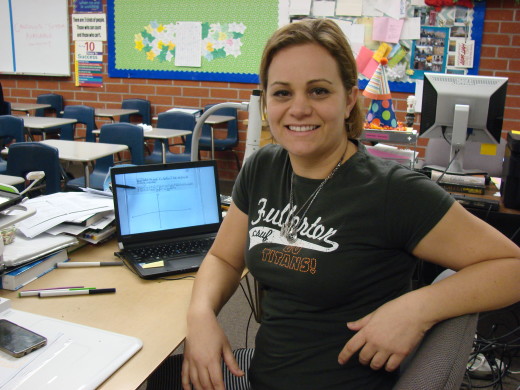
Shannon Atkins displays one of her many video lessons that she utilizes in her flipped classroom. Photo by Kaitlyn Ngo.by Kaitlyn Ngo and Amy Vu, Staff Writers and Photographers
Shannon Atkins, a math teacher at Fountain Valley High School, explains about a teaching method she has where she flips the classroom.
A flipped classroom is a method of teaching where lectures and lessons are viewed at home and class time is devoted to discussion, questions, and additional practice.
This model is starting to be largely integrated with curriculum as teachers feel it is more beneficial and helpful to students.
Atkins is the one of the first teachers on campus to pioneer this new model of teaching. She believes that it is a great tool to use in the classroom and tries to utilize this method once a week.
“I think [flipped classrooms] is pretty cool. It’s not necessarily good for a daily thing, but for the easier lessons, I think it’s a really good strategy.”
Atkins first learnt of this method of teaching from other math teachers at other schools in the district. Soon after, she discovered how it worked, how the teachers were utilizing this tool, and decided to give it a shot.
Atkins finds that instant feedback is how the students benefit most from this teaching style. Students can view and learn the material at home, then at school, they can seek help and obtain a better understanding of the lesson.
Another effective teaching tool that Atkins mentions is PlayPosit, a program on Canvas that allows her to produce and upload videos and embed questions that quiz students and provide them with easy points. Atkins makes use of this program to ensure that her students watch and pay attention during the educational videos.
Noting strengths and weaknesses of having a flipped classroom, Atkins describes how it affects the students and their learning process.
For strengths, students have the ability to practice in class and get feedback instantaneously. Due to the lesson being learnt at home, more class time can be dedicated to the actual material and students asking questions. It gives them the opportunity to ask for clarification during the whole fifty-five minute period, allowing for students to grasp a better understanding of the material.
The downside of teaching with a flipped classroom is that it is a lot more work for teachers. Making videos and planning lessons takes time to film, edit, and upload. Atkins notes that this is an occurring issue as she often has technical difficulties filming and editing the videos on her iPad.
Though, it does have its advantages and drawbacks, she encourages other teachers to experiment and try out the “flipped classroom” method. She views the flipped classroom as an effective strategy for teaching. Because of the positive results she received, she decided to permanently integrate it into her teaching for the rest of the year.
“Let’s do it. Let’s do it more,” she said.





